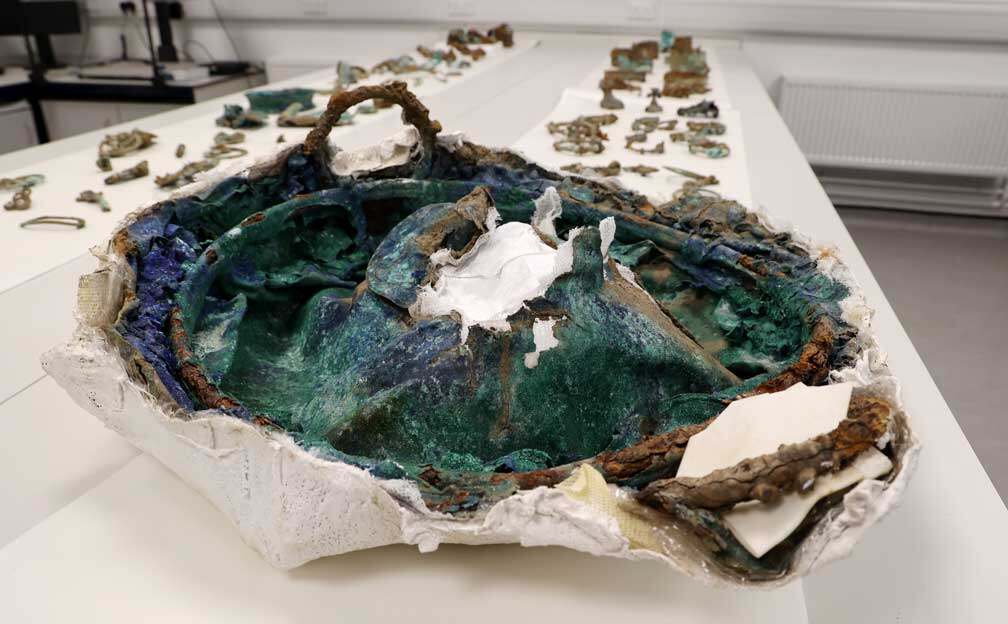Historic England, Durham University and the British Museum have announced the discovery of the Melsonby Hoard: one of the largest and most important Iron Age finds in the UK. The hoard is vast, totalling some 800 artefacts.


The University of Southampton used sophisticated X-ray CT scanning to help identify a collection of dozens of objects – encased in a heavy soil block – which form part of the find.
The Melsonby Hoard provides an archaeological time capsule from the Iron Age, altering our understanding of life in Britain 2,000 years ago. Initial assessment suggests the objects were buried in the first century AD, around the time of the Roman conquest of Southern Britain. Many of the objects are vehicle parts.https://if-cdn.com/XXbqSLS
Discovered and reported in December 2021 by metal detectorist Peter Heads, the hoard was excavated in 2022 by a team of archaeologists from Durham University, with advice from the British Museum and a grant of over £120,000 from Historic England. The Yorkshire Museum is now launching a fundraising campaign to secure it for the nation.
The quantity and variety of objects are unusual for Iron Age Britain and have important implications for reassessing our understanding of the nature and use of vehicles at the time. This could lead to a major re-evaluation of how wealth and status were expressed.
Vehicle components include the partial remains of more than seven four-wheeled wagons or two-wheeled chariots. The find also includes elaborate harnesses for at least 14 ponies, three ceremonial spears, and two ornate cauldrons – one lidded and likely used as a wine mixing bowl.


Cast copper alloy bridle bits, linchpins, rein rings and harness fittings were found within a cluster of 28 iron tyres from horse drawn vehicles. Some of the tyres had been intentionally bent out of shape and cauldrons were carefully placed upside down.
Lead investigators turned to the University of Southampton for help to examine one particular collection, removed from the ground within in a large earth block, weighing around 250 kg.
Experts at the University’s μ-VIS X-Ray Imaging Centre used cutting edge X-ray CT scanning technology to look inside the block to identify the objects, their positioning, and to help aid their safe excavation in the laboratory at a later date.
The centre operates the biggest high-energy micro-focus CT scanner of any UK University – capable of examining very large, dense objects.
Dr Mark Mavrogordato , Director of the μ-VIS X-Ray Imaging Centre, comments: “The block posed a significant challenge for our team, due to its large size, heavy weight and dense structure – pushing the boundaries of our facility. But by making a bespoke wooden support to encase it, and employing our ‘can do’ thinking, the scan was a success, showing the secrets locked inside.”


The block was found to contain many harness pieces (bits and strap fittings), spears, wheel nave bands, linchpins, and finials from a vehicle. The team at μ-VIS also scanned one of the crushed cauldrons revealing its structural properties and a beautiful fish decoration on its base inside.
The work at the µVIS centre was supported by the EPSRC’s National Research Facility for lab-based X-ray Computed Tomography ( NXCT ).
Commenting on the hoard, Duncan Wilson, Chief Executive of Historic England, said: “Quite simply, this is one of the most important and exciting Iron Age period discoveries made in the UK. It sheds new light on Iron Age life in the north and Britain, but it also demonstrates connections with Europe.
“Its proximity to the great Iron Age enclosure at Stanwick is an important factor in understanding its significance. Historic England understood the importance of this find from the moment it was reported to us, and we’re thrilled we were able to provide grant support to allow its excavation and initial conservation.”
Professor Tom Moore, Head of the Department of Archaeology at Durham University, said: “Whoever originally owned the material in this hoard was probably a part of a network of elites across Britain, into Europe and even the Roman world.
“The destruction of so many high-status objects, evident in this hoard, is also of a scale rarely seen in Iron Age Britain and demonstrates that the elites of northern Britain were just as powerful as their southern counterparts.”
Dr Sophia Adams, Curator, First Millennium European and Roman Conquest period Collections, the British Museum, said: “This is the largest single deposit of horse harness and vehicle parts excavated in Britain. It is significant not just for the quantity of objects buried together 2,000 years ago but also the quality and range of items. These finds shed new light on collections at the British Museum that were discovered in the 19th and 20th centuries.”








































